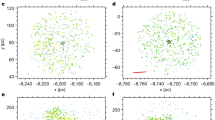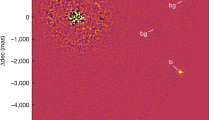Abstract
Most stars and their planets form in open clusters. Over 95 per cent of such clusters have stellar densities too low (less than a hundred stars per cubic parsec) to withstand internal and external dynamical stresses and fall apart within a few hundred million years1. Older open clusters have survived by virtue of being richer and denser in stars (1,000 to 10,000 per cubic parsec) when they formed. Such clusters represent a stellar environment very different from the birthplace of the Sun and other planet-hosting field stars. So far more than 800 planets have been found around Sun-like stars in the field2. The field planets are usually the size of Neptune or smaller3,4,5. In contrast, only four planets have been found orbiting stars in open clusters6,7,8, all with masses similar to or greater than that of Jupiter. Here we report observations of the transits of two Sun-like stars by planets smaller than Neptune in the billion-year-old open cluster NGC6811. This demonstrates that small planets can form and survive in a dense cluster environment, and implies that the frequency and properties of planets in open clusters are consistent with those of planets around field stars in the Galaxy.
This is a preview of subscription content, access via your institution
Access options
Subscribe to this journal
Receive 51 print issues and online access
$199.00 per year
only $3.90 per issue
Buy this article
- Purchase on Springer Link
- Instant access to full article PDF
Prices may be subject to local taxes which are calculated during checkout



Similar content being viewed by others
References
Lada, C. J. & Lada, E. A. Embedded clusters in molecular clouds. Annu. Rev. Astron. Astrophys. 41, 57–115 (2003)
The Extrasolar Planets Encyclopaedia. http://exoplanet.eu (2012)
Mayor, M. et al. The HARPS search for southern extra-solar planets XXXIV. Occurrence, mass distribution and orbital properties of super-Earths and Neptune-mass planets. Astron. Astrophys. (submitted); preprint at http://arxiv.org/abs/1109.2497
Howard, A. et al. Planet occurrence within 0.25 AU of solar-type stars from Kepler. Astrophys. J. Suppl. 201, 15–35 (2012)
Fressin, F. et al. The false positive rate of Kepler and the occurrence of planets. Astrophys. J. 766, 81–99 (2013)
Sato, B. et al. A planetary companion to the Hyades giant Epsilon Tauri. Astrophys. J. 661, 527–531 (2007)
Lovis, C. & Mayor, M. Planets around evolved intermediate-mass stars. I. Two substellar companions in the open clusters NGC2423 and NGC4349. Astron. Astrophys. 472, 657–664 (2007)
Quinn, S. et al. Two “b”s in the beehive: the discovery of the first hot Jupiters in an open cluster. Astrophys. J. 756, L33–L36 (2012)
van Saders, J. L. & Gaudi, B. S. Ensemble analysis of open cluster transit surveys: upper limits on the frequency of short-period planets consistent with the field. Astrophys. J. 729, 63–76 (2011)
Pace, G., Pasquini, L. & Francois, P. Abundances of four open clusters from solar stars. Astron. Astrophys. 489, 403–412 (2008)
Fischer, D. A. & Valenti, J. The planet-metallicity correlation. Astrophys. J. 622, 1102–1117 (2005)
Meibom, S. The Kepler Cluster Study. Bull. Am. Astron. Soc. 43, (AAS Meeting 218) abstr. 311.03. (2011)
Yi, S. et al. Toward better age estimates for stellar populations: the Y2 isochrones for solar mixture. Astrophys. J. Suppl. 136, 417–437 (2001)
Girardi, L., Bressan, A., Bertelli, G. & Chiosi, C. Evolutionary tracks and isochrones for low- and intermediate-mass stars: from 0.15 to 7 MO, and from Z = 0.0004 to 0.03. Astron. Astrophys. 141 (Suppl.). 371–383 (2000)
Jenkins, J. M. et al. Overview of the Kepler Science Processing Pipeline. Astrophys. J. 713, L87–L91 (2010)
Meibom, S. et al. The Kepler Cluster Study: stellar rotation in NGC6811. Astrophys. J. 733, L9–L12 (2011)
Janes, K., Barnes, S. A., Meibom, S. & Hoq, S. NGC6811: an intermediate-age cluster in the Kepler field. Astron. J. 145, 7–21 (2013)
Weiss, L. M. et al. The mass of KOI-94d and a relation for planet radius, mass, and incident flux. Astrophys. J. 768, 14–32 (2013)
Scally, A. & Clarke, C. Destruction of protoplanetary discs in the Orion nebula cluster. Mon. Not. R. Astron. Soc. 325, 449–456 (2001)
Bonnell, I. A. et al. Planetary dynamics in stellar clusters. Mon. Not. R. Astron. Soc. 322, 859–865 (2001)
Smith, K. W. & Bonnell, I. A. Free-floating planets in stellar clusters? Mon. Not. R. Astron. Soc. 322, L1–L4 (2001)
Fregeau, J. M., Chatterjee, S. & Rasio, F. A. Dynamical interactions of planetary systems in dense stellar environments. Astrophys. J. 640, 1086–1098 (2006)
Adams, F. C., Proszkow, E. M., Fatuzzo, M. & Myers, P. C. Early evolution of stellar groups and clusters: environmental effects on forming planetary systems. Astrophys. J. 641, 504–525 (2006)
Malmberg, D. et al. Close encounters in young stellar clusters: implications for planetary systems in the solar neighbourhood. Mon. Not. R. Astron. Soc. 378, 1207–1216 (2007)
Spurzem, R., Giersz, M., Heggie, D. C. & Lin, D. N. C. Dynamics of planetary systems in star clusters. Astrophys. J. 697, 458–482 (2009)
Haisch, K. E., Lada, E. A. & Lada, C. J. Disk frequencies and lifetimes in young clusters. Astrophys. J. 553, L153–L156 (2001)
Kroupa, P. The IMF of simple and composite populations. Astron. Soc. Pacif. Conf. Ser. 390, 303–315 (2008)
Gautier, T. N. et al. Kepler-20: a Sun-like star with three sub-Neptune exoplanets and two Earth-size candidates. Astrophys. J. 749, 15–33 (2012)
Acknowledgements
Kepler was competitively selected as the tenth Discovery mission. Funding for this mission is provided by NASA’s Science Mission Directorate. S.M. acknowledges support through NASA grant NNX09AH18A (The Kepler Cluster Study) and from the Kepler mission via NASA Cooperative Agreement NCC2-1390. G.T. acknowledges support through NASA’s Kepler Participating Scientist Program grant NNX12AC75G. L.A.R. acknowledges NASA support through Hubble Fellowship grant HF-51313.01-A awarded by the Space Telescope Science Institute, which is operated by the Association of Universities for Research in Astronomy, Inc., for NASA, under contract NAS 5-26555.
Author information
Authors and Affiliations
Contributions
S.M. is the Principal Investigator of The Kepler Cluster Study and led the writing of the paper and the effort to identify members of NGC6811. He worked with G.T. and F.F. on characterization and validation of Kepler-66b and Kepler-67b, and with K.J. and S.A.B. on determination of the properties of NGC6811. G.T. developed the BLENDER software used to validate the planets, and determined the stellar properties of the host stars. F.F. worked on the BLENDER validation of the two planets and the Monte-Carlo simulation of the cluster yield. D.W.L. contributed follow-up spectroscopy of host stars. J.F.R. performed the light-curve analysis to extract the planet characteristics. D.R.C. provided constraints on angular separation of potential background blends from adaptive optics imaging. S.T.B. performed pixel-level centroid analysis. C.E.H. assisted in running BLENDER on the NASA Pleiades supercomputer. L.A.R. modelled the planets’ interior structure to constrain the range of possible masses and compositions. K.J. led the supporting photometric study from which the bulk properties of NGC6811 are derived. S.A.B. participated in the acquisition of ground-based spectroscopic and photometric data on NGC6811. G.W.M. and H.I. obtained and analysed high-resolution Keck HIRES spectra of the host stars used for the BLENDER analysis. D.A.F. analysed HIRES spectra using the Spectroscopy Made Easy software. S.B.H. and E.P.H. obtained and analysed speckle observations of the host stars. J.M.J. led the efforts of data collection, data processing and data review that yielded the Kepler time series photometry. S.C.S. did spectroscopic analysis of stellar members of NGC6811 to aid in the determination of cluster parameters including metallicity. J.C. obtained adaptive optics imaging observations.
Corresponding author
Ethics declarations
Competing interests
The authors declare no competing financial interests.
Supplementary information
Supplementary Information
This file contains Supplementary Text and Data 1-4, Supplementary Figures 1-3 and additional references. (PDF 3389 kb)
Rights and permissions
About this article
Cite this article
Meibom, S., Torres, G., Fressin, F. et al. The same frequency of planets inside and outside open clusters of stars. Nature 499, 55–58 (2013). https://doi.org/10.1038/nature12279
Received:
Accepted:
Published:
Issue Date:
DOI: https://doi.org/10.1038/nature12279
This article is cited by
-
HAYDN
Experimental Astronomy (2021)
-
Planet host stars in open clusters
Science China Physics, Mechanics & Astronomy (2015)
-
The robustness of planet formation
Nature (2013)
Comments
By submitting a comment you agree to abide by our Terms and Community Guidelines. If you find something abusive or that does not comply with our terms or guidelines please flag it as inappropriate.



